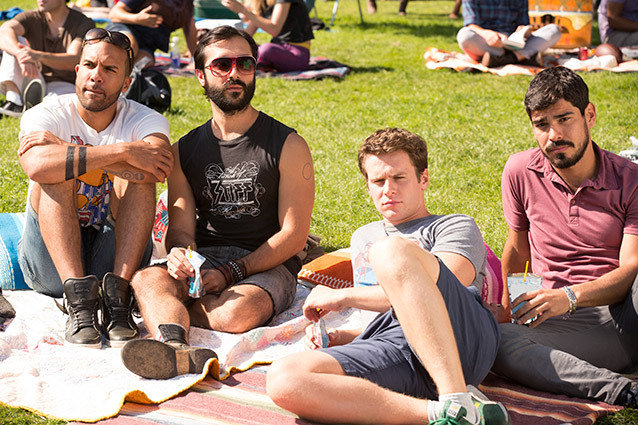 HBO
HBO
A lot has happened in the 13 years since Queer as Folk premiered in December of 2000. Celebrities are out of the closet, Don’t Ask Don’t Tell is dead, gay marriage is legal (sort of), and tons of shows have gay characters. However, homophobia is still a global issue, gay bashings are rampant, and HIV stats haven’t gone down. HBO’s new series Looking offers a glimpse at gay men on the other side of those 13 years. But is it an upgrade or a downgrade from the Showtime series?
Queer as Folk is an American version of a popular British series. It is historical for having the first sex scene between two men on American television. Despite (or possibly because of) its graphic sex scenes and unabashed drama, it became a flagship series for Showtime. It’s a precursor to other addictive series like Dexter, Weeds, Homeland, and new series Masters of Sex. Looking, on HBO, follows the ever-popular Girls on Sunday nights. It is vastly different in tone, format, and content from Queer as Folk. But is it a sign of tolerance towards the gay community or a step backwards for representation of gay men in the media?
UPGRADE
Location
Queer as Folk is set in Pittsburgh but shot in Canada, and gives a fantastical version of the small Pennsylvania city’s gay population. Conversely, Looking is set in San Francisco, actually films there, and gives an honest portrayal of life in the city. This gives a more balanced view of gay men’s lives beyond stereotypical expectations.
Gay Cast Members
The bulk of the cast of Queer as Folk was straight. Its stars Peter Paige, Randy Harrison, and Robert Gant are all out actors, but they reached their notoriety because of the show. Conversely, Looking‘s Jonathan Groff and British actor Russell Tovey are coming to the show established out actors. Their stardom is a definite draw to the show.
More Realistic
Looking opts for a more realistic approach to portraying the lives of its characters. It’s more of a slice of life and less a soap opera or sitcom. The characters have real jobs, have long involved discussions about relationships, and just hang out. This differs from Queer as Folk’s exaggerated world of constant clubbing and consistent sex. Furthermore, Looking offers insight into awkward experiences only gay men can have. Most often, Patrick (Groff) will get into an uncomfortable verbal exchange with a potential lover or boyfriend. It humanizes the characters and makes them more relatable.
Smaller Cast
Looking zeroes in on three friends and the people in their lives. That differs greatly from the large cast of Queer as Folk. This allows for the characters to be more fully developed and to focus less on having to give everyone a storyline each episode.
DOWNGRADE
Ignores Issues
There isn’t pressure for Looking to get super political. As the first gay-themed show on television, Queer as Folk takes the opportunity to unabashedly reveal all kinds of issues affecting the gay community like drug addiction, HIV, and gay bashing. Looking ignores safe sex, HIV, and homophobia, which are still important issues worldwide, even in San Francisco. It doesn’t need to dwell on them but should at least acknowledge they exist. It takes a second for a character to grab a condom or mention using it.
Smaller Spectrum of the Gay Community
Queer as Folk offers a United Colors of Benetton composite of the gay community. The core cast includes men on various parts of the masculine/feminine spectrum, lesbian cast members, and straight allies. San Francisco is renowned for its large gay population, queer activists, and transgendered men and women, but Looking only seems to follow a group of mostly-masculine, Grindr/OkCupid-obsessed, white-washed, gay men… with beards. That doesn’t give a very balanced view to the audience at large.
Race Issues
Queer as Folk is not a trailblazer of ethnic diversity. Looking actually has more people of color in the main cast than the Showtime series. However, the men on Queer as Folk were race-blind in their choice of sex and romantic partners. They never exoticized them or commented on their race. Looking sloppily brings up race and sex but it doesn’t open up a discourse about racism in the gay community; instead it marginalizes people of color.
Tamer
Queer as Folk is fueled by sex, nudity, and relationships. Looking opts for fewer sex scenes and less nudity. It is a great attempt at diminishing stereotypes of gay men being sex obsessed, and yet, the characters on Looking mostly discuss sex and check Grindr and OkCupid obsessively; plus, Patrick hits on every guy he meets. If the end result is still the same then why not opt for the sex scenes? After all, sex sells.
The end result is a draw. Queer as Folk is a show with no prior frame of reference for representations of gay men on television. It’s not perfect, but it’s a guilty pleasure that opens a dialogue about important gay issues. Thirteen years later, Looking opts-out of politics and some stereotypes while furthering others. However, it doesn’t have the luxury of not knowing any better.


